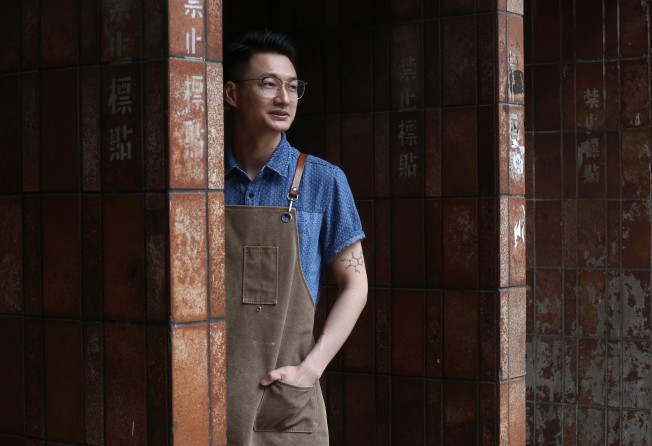
Hong Kong chef Ray Choi uses his fine dining experience to experiment with local ingredients
- His mother first taught him how to cook, even if the reluctant chef ‘preferred mopping the floor’ to stir-frying or braising
- Stints at L’Atelier de Joël Robuchon, the Mandarin Grill and Tate Dining Room led him to high-end catering company Butler

How did you start cooking? “When I was 12 years old, my mother wanted me, my older brother and my sister to help around the home – wash the dishes, clean up or cook. We started by washing vegetables and chopping ingredients, then we learned to stir-fry and braise.
“Cooking wasn’t something I chose – whoever was free helped to do whatever needed to be done. I preferred mopping the floor. But as my mum taught me more, I saw how cooking techniques affected the finished dish, which made me interested. Her cooking is pretty good and she had the patience to teach us. She told us things like, for choi sum, the stems need to be cooked longer than the tips, and I used this information later.
“After she taught me simple dishes, I started cooking them differently. For example, my father is from Chiu Chow [Chaozhou, in Guangdong province], where there is a dish of minced pork with small clams, shallots, garlic and seasoning. I did my own version using Thai basil, lime leaf or lime juice.”
What was your first restaurant job? “I started working in restaurants after high school, when I was 17 years old. A friend got me a job as a waiter in a Western restaurant in Tsim Sha Tsui – there were no kitchen positions at the time.

“Six months later a job opened up. They started me off easy in the cold kitchen, preparing salads, dressings and smoked salmon. I watched others in butchery and making soups. Then, in 2005, a relative suggested I take courses at the Vocational Training Council, so I learned Western cuisine with a focus on butchery, and took other courses in bakery and desserts.”
What do you like about fine dining? “After I graduated, in 2006, I worked at the Jockey Club, in Happy Valley, for four years; two in the cafe and two in The Derby Restaurant. I also took part in competitions at Hofex and Sopexa, winning first prize in 2007, creating a pork tenderloin with pea purée and cheese sauce.
“I liked working in The Derby because it was my first experience with fine dining. Everything is much more detailed, like chopping ingredients in a finer way – it’s much harder and I learned a lot. I was under chef Donovan Cooke, who apprenticed under Marco Pierre White and Michel Roux.
“[Cooke] taught me a lot, like how to cook vegetables and make a soup out of them, how to carve meat and marinate it, and how to make sauces. I like watching others prepare food – they don’t have time to explain; I ask questions afterwards.
“In 2010, I worked at the Mandarin Grill + Bar under chef Uwe Opocensky. There I learned a lot more, such as making an intricate salad, how to choose oysters and open them. Whenever the oyster shipment arrived, I got to try some. In a hotel kitchen you can see so many more things. For example, an Indian chef at the hotel taught me how to make a curry, and the hotel would have promotions, so I could learn the basics about Thai or Spanish cuisine.”
I worked briefly at L’Atelier de Joël Robuchon, helmed by chef Olivier Elzer. I was only there for a few months because, to be honest, it was tough
What was your hardest job? “I worked briefly at L’Atelier de Joël Robuchon, helmed by chef Olivier Elzer. I was only there for a few months because, to be honest, it was tough. It was a lot of pressure because it was a big-name restaurant with three Michelin stars. If I made a mistake, I’d sometimes get complaints from customers and chef Olivier taught me how to correct my mistakes. After my shift, I spent time in the butchery. If you spend your spare time in the kitchen, you can really learn things.”
Which chef did you work with best? “I got a job at Tate Dining Room. It was a 26-seat restaurant – much smaller than Robuchon, which was three times the size. I could focus more on the details of putting dishes together and experiment more.
“Chef Vicky Lau has good ideas and likes using local or Japanese ingredients. Working with her for five years didn’t feel like a long time, but it was time to move on and see other things, so I joined Arbor in 2018, with chef Eric Räty. He likes using Japanese ingredients, too, like kombu [sea kelp], bonito flakes, sansho pepper and sake.
“Now I’m at Butler, which is a high-end catering company that prepares lunches, dinners and afternoon tea sets for corporate clients. Some are fashion houses from Europe, so I get to explore their cuisines.”

What did you cook at Test Kitchen when you were guest chef there recently? “I like experimenting with local ingredients by using different techniques and temperatures. For example, we aged local duck for nine days and then used koji – fermented rice – to marinate and tenderise it. Another example is a typical homestyle dish steamed with preserved vegetables, but we used the sous-vide method to cook the fish and finished it with Sichuan peppercorns.”
How do you spend your days off? “I enjoy learning about Chinese tea. Right now, I like drinking dragon well tea. I attend tea workshops when I have time. I need to practise making tea, it’s much like how artisanal coffee is prepared.”